If you are planning to create an eWallet app, this blog is for you.
Mobile app development can be a complex process with a lot of bits that require a lot of attention. One such element is the tech stack.
eWallet app tech stack is very important as it can dictate various aspects of the platform.
But how and what is a tech stack at all? Well, in this blog, we shall be discussing all you need to know about the eWallet app development tech stack, common options, how to build a custom tech stack, considerations when choosing a tech stack, and more.
So with this being said, let’s get right into it:
App Tech Stack: An Overview
Let’s answer the most important question first, what’s a tech stack?
The mobile app tech stack refers to the technologies used in the app development process. Therefore, when we are talking about the tech stack for the eWallet app, it covers all the technology and components involved in app development.
This covers everything from development tools, programming languages, frameworks, APIs, third-party components, and so on.
But why is tech stack important? Let’s answer this question.
The Importance of Choosing the Right eWallet App Tech Stack
If you want to create an eWallet app, then you must not underestimate the importance of the eWallet tech stack.
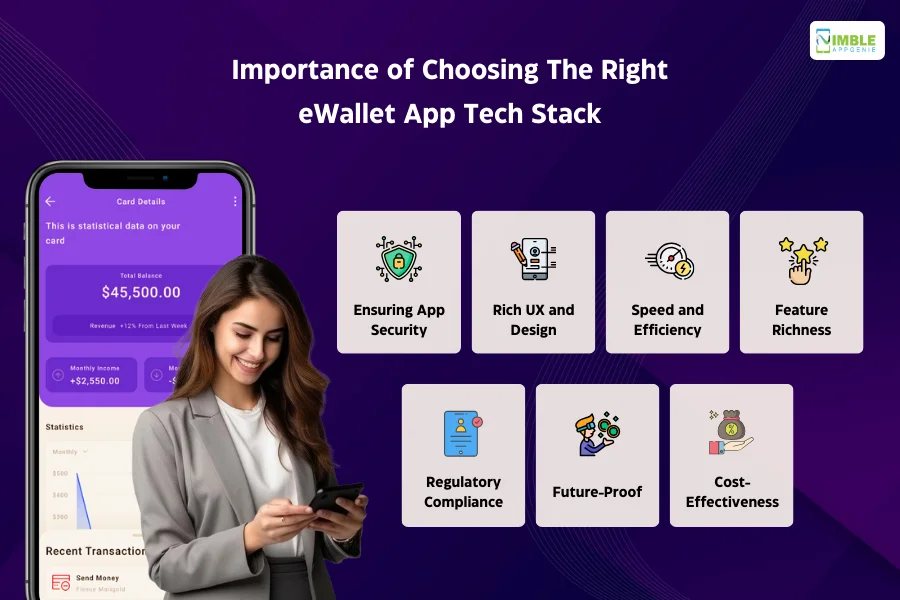
This begs the question, why is choosing the best eWallet app tech stack so important?
Well, there are various reasons why choosing the right tech stacks is so important in the app development process. In this section, we shall be going through some of these.
Ensuring App Security
When we are talking about eWallet apps that handle sensitive fintech data, app security becomes very important.
eWallet app development technologies can highly affect the security level. Therefore, it’s important to choose the right tech stack considering the app idea.
In fact, it is only with the right combination of technologies that you can ensure full-proof eWallet app security.
To Create a rich User Experience and App Design
It goes without saying that the app’s usability is paramount.
The tech stack should enable the creation a user-friendly interface that’s easy to navigate, visually appealing, and responsive across different devices and operating systems.
All in all, development technologies selection directly affects eWallet app design.
Speed and Efficiency
One of the biggest Tech stack use for eWallet app is speed and efficiency.
In other words, users expect instant transactions and quick responses, something achieved only with the right combination of technologies.
The chosen technology should be optimized for performance, ensuring fast loading times, smooth transitions, and minimal lag.
Feature Richness
Modern eWallets offer various features beyond basic transactions.
The tech stack should be flexible and adaptable to support features like budgeting tools, loyalty programs, bill payments, and even integration with wearables.
All in all, the tech stack becomes very important if you want to deliver top-notch eWallet app features.
Regulatory Compliance
eWallets (and the fintech industry as a whole) operate in a highly regulated environment.
The tech stack needs to be built with regulations in mind, ensuring compliance with KYC/AML, data privacy laws, and other relevant financial regulations.
Future-proof
Technology evolves rapidly and if you want becoming successful among people, you have to be future-proof. In other words, you need to create a digital wallet app that stands against the test of time.
The chosen tech stack used for digital wallet app development should be based on established but evolving technologies.
Thus, allowing for future integrations and scalability to stay ahead of the curve.
Cost-effectiveness
While choosing top-notch technologies is important, the Cost to build an eWallet can reach well over a million if not kept in check.
The tech stack should be selected to offer optimal performance and security within your development budget.
So, these are the reasons why it’s important to choose the right and best technology for a digital wallet app. With this out of the way, let’s move to the next section where we shall be looking at app tech stack.
Popular eWallet Apps and Their Tech Stack
The market is filled with popular digital wallet apps that are making billions in revenue.
So, if you want to be the next best thing, you might as well learn from the best. So let’s look at three popular eWallet applications and their tech stack.
1. PayPal
Let’s start with the OG digital wallet and one of the most well-known names in the market, PayPal.
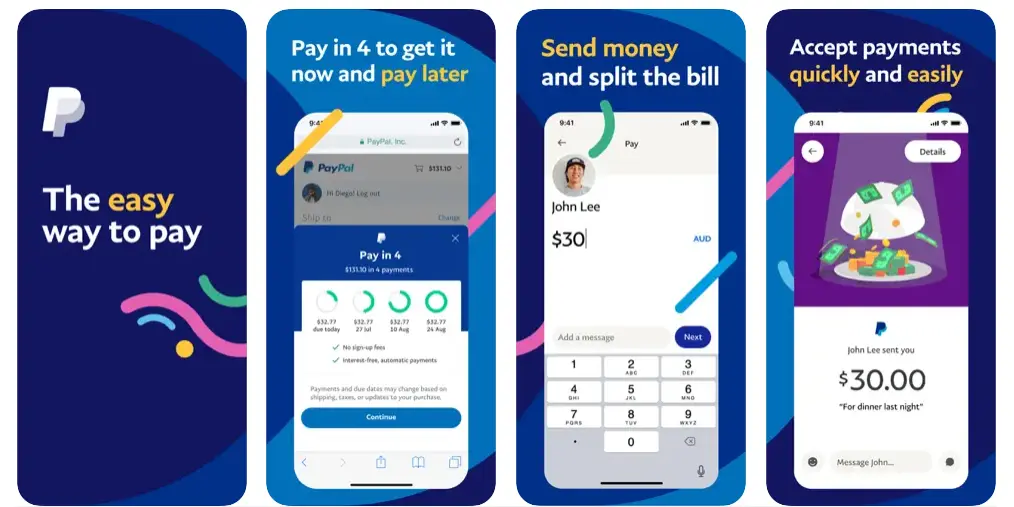
Their success story has inspired a lot of companies to invest in apps like PayPal and some of them are market leaders themselves.
So, what’s the secret formula behind this success? Well, let’s look at the Technologies used to develop the eWallet app in question:
| Category | Technologies |
| Frontend | HTML5, CSS3, JavaScript (jQuery, ReactJS), Bootstrap, Material Design, RESTful APIs |
| Backend | Java, Node.js, Python, PHP, Spring Framework, Express.js, MySQL, Cassandra, HBase, Apache Kafka, RabbitMQ, GCP, AWS |
| Payment Gateways | Proprietary gateway, integrations with Visa and Mastercard |
| Security | Multi-factor authentication, data encryption, fraud prevention, vulnerability management |
| DevOps Tools | Git, Jenkins, Gradle, Docker, Kubernetes |
| Analytics | Google Analytics, Sumo Logic, Logic Monitor |
| Cloud Storage | Google Cloud Storage, Amazon S3 |
2. Venmo
Venmo, known for its social payments and peer-to-peer transfers, employs a modern tech stack that prioritizes scalability, performance, and user experience.
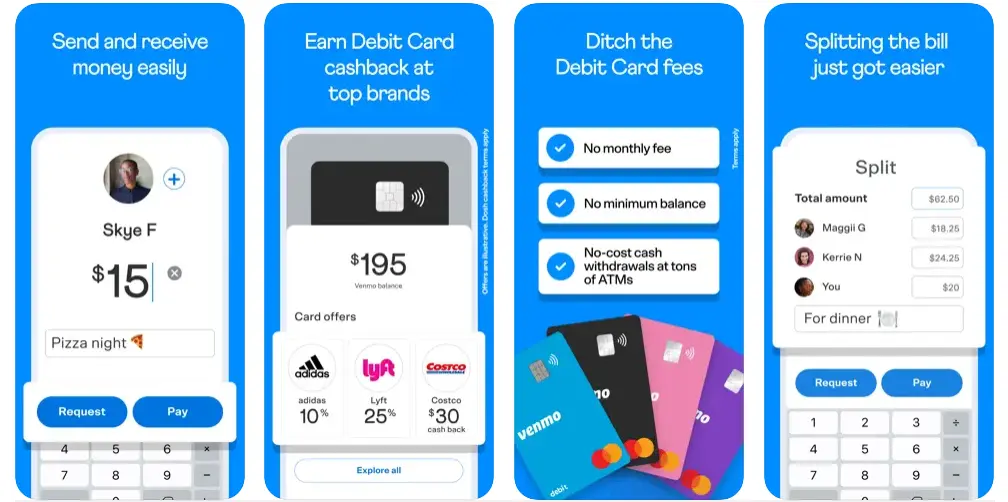
So, let’s look at the tech stack used to make this one of the best NFC payment apps in the market:
| Category | Technologies |
| Frontend | HTML5, CSS3, JavaScript (React Native), React Native, Redux, RESTful APIs |
| Backend | Java, Python, Go, Spring Framework, Flask, MySQL, Cassandra, Apache Kafka |
| Payment Gateways | PayPal |
| Security | Multi-factor authentication, data encryption, fraud prevention, vulnerability management |
| DevOps Tools | Git, Jenkins, Docker, Kubernetes |
| Analytics | Amazon Kinesis, Amazon Redshift, Looker |
| Push Notifications | APNs, Firebase Cloud Messaging |
| Cloud Platform | AWS |
3. TransferWise
TransferWise has been leading the charge in the international payment niche.

If you want to join the ranks of top cross-border payment apps, here’s the tech stack used by this market leader.
| Category | Technologies |
| Frontend | HTML5, CSS3, JavaScript |
| Frameworks | React, AngularJS (legacy) |
| Backend | Java, Groovy, Python |
| Frameworks | Spring Boot and Grails |
| Databases | PostgreSQL, MariaDB, MongoDB |
| Messaging | Apache Kafka |
| Cloud Provider | AWS |
| Cloud Services | EC2, S3, RDS, EMR, Kafka Streams |
| DevOps Tools | Git, GitHub, Kubernetes, Docker, Terraform, Ansible, Jenkins, Gradle |
| Monitoring | New Relic, Prometheus, Grafana |
| Logging | Logstash, Elasticsearch, Kibana |
Now that we are done with eWallet tech stack examples, let’s look at a few of the commonly used ones in the section below.
Common Tech Stack for eWallet App
eWallet is a trending niche in the wider fintech app development category. Today, there are well over a million digital wallet solutions across the globe.
Now, before we discuss the custom digital wallet app tech stack, let’s look at some commonly used ones. These are, as mentioned below:
1] Node.js + Express.js + MongoDB + React Native
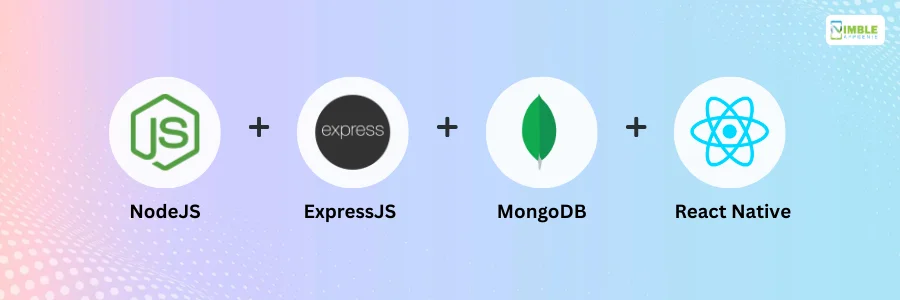
Being based on the JavaScript-based ecosystem, this tech stack offers superior data modeling flexibility, scalability, and efficiency. Driven by react native, you can expect native-like performance.
Furthermore, it can also be used for hybrid app development, since react native is being used.
Best For
This eWallet app tech stack powered by React native app development enables rapid prototyping. And this is also very suitable for data-heavy applications with flexible schema as well as apps that require superior performance.
2] Java + Spring Boot + PostgreSQL + Flutter
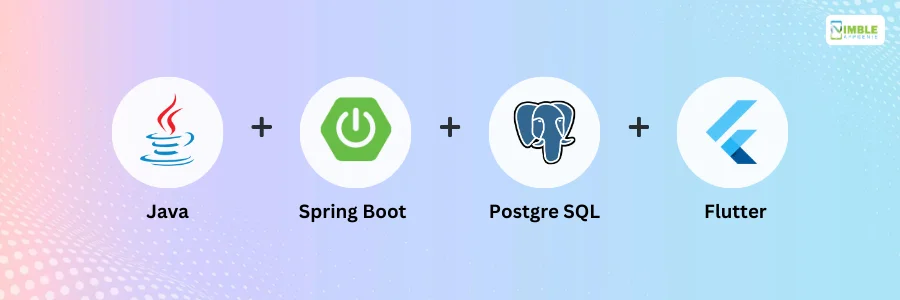
Java + Spring boot is a powerful combination that lets you build robust and mature ewallet apps, fast. Flutter opens doors to cross-platform app development, while giving loads of pre-designed widgets. Don’t forget the native-like performance.
Best For
These combinations of technologies are used for enterprise application development. Being a powerful combination, it can also be used to create data-intensive applications with strict schema requirements. If you want to create visually appealing apps, this is the best technology for ewallet apps.
3] Python + Django + SQLite + Angular
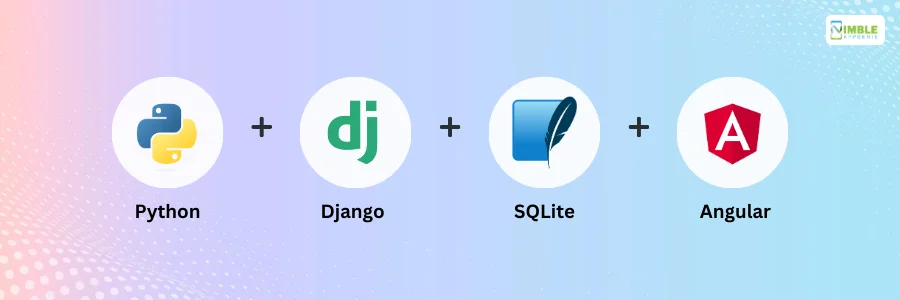
Driven by the power of Python, it delivers rapid development, strong app architecture, and clean design principles. Harnessing the power of Python and Django, it is a powerful
Best For
With the versatility of Python backed by Django, SQLite, and Angular, it is the perfect tech stack to bring start-up fintech ideas to reality, simpler apps, prototyping, as well as large-scale web apps. Don’t miss the point that it teams with a strong TypeScript experience.
Now that we are done with the pre-set technology used to develop a digital Wallet, let’s move towards building a custom tech stack in the section below.
Build a Custom Tech Stack for eWallet App Development
With all that said and done, it’s finally time to look at the custom Digital Wallet app development tech stack. There are various technologies that you can choose and combine to build your own tech stack.
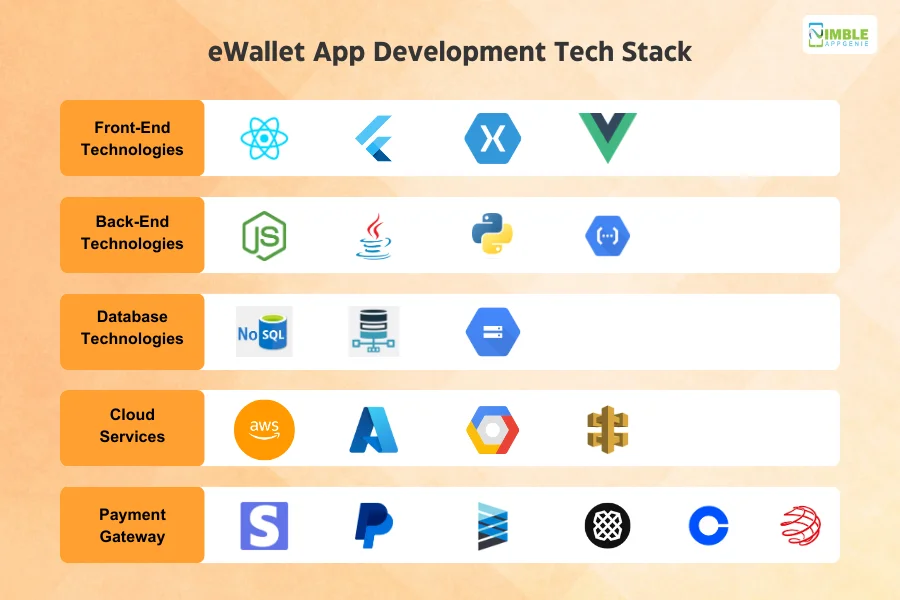
Let’s see what the available technologies are.
1) Front-End Technologies Used To Develop eWallet App
Front-end technologies used to develop the eWallet app mainly cover app frameworks. Take a look at them below.
React Native
With lots of companies who want to build react native app, it is one of the most popular choices.
This technology offers cross-platform development for iOS and Android with a single codebase, boosting efficiency and consistency. Now, there are various other benefits to it, but that’s the gist of it.
Flutter
Flutter for app development has become a popular choice in the fintech industry with all the benefit this Google backed technology offer. Including its fast performance and expressive UI capabilities.
And yes, this is another popular cross-platform option.
Speaking of which, React Native vs Flutter has been a popular debate, something that a lot of our eWallet clients find to be a hurdle, learn which one is better in this blog: React Native vs Flutter
Xamarin
Xamarin is a leading Android app development framework.
Therefore, it can be a mature option for building native-like mobile apps with C# and leveraging existing NET expertise.
React or Vue.js
Lastly, if you want to go for PWA development, these JavaScript frameworks provide interactive and dynamic UI experiences.
Now that we are done with the front-end frameworks, it’s time to move to back-end options in the section below.
2) Back-End Technologies Used To Develop Digital Wallet
With the front-end technology of the tech stack used for digital wallet apps done, it’s time to look at some popular back-end framework choices for digital wallets.
Node.js
NodeJS development has become quite popular in the market recently.
After all, being a lightweight and fast runtime environment, it is for building real-time and scalable server-side applications.
A range of NodeJS frameworks has held a place in the best tech stack for your digital wallet app, making it worth considering.
Some of these are, as mentioned below:
| Framework | Focus | Features | Pricing |
| Express.js | Minimalist & Versatile | Routing, middleware, templating, error handling | Free |
| Koa.js | Next-Gen Express | Error handling, async/await support, middleware | Free |
| Nest.js | Enterprise-Ready | MVC architecture, TypeScript support, dependency injection | Free |
| Sails.js | MVC & Data Driven | Waterline ORM, MVC structure, built-in authentication | Free |
| Total.js | Full-Stack Framework | MVC, routing, ORM, templating, authentication | Free |
| Hapi.js | Secure & Scalable | Security focus, routing, plugins, validation | Free |
| Feather.js | Microservices & API-First | Lightweight core, plugins for features, RESTful APIs | Free |
| Loopback.js | API Development & Data Management | RESTful APIs, built-in connectors, data modeling | Free |
| Adonis.js | MVC & TypeScript | MVC architecture, TypeScript support, validation | Free |
| Derby.js | Real-Time Applications | Real-time communication, data synchronization, DOM manipulation | Free |
Java/Spring Boot
Java and Spring Boot, it is robust and industry-standard choices for back-end development.
In fact, this is especially preferred when dealing with complex financial transactions. A fact that makes it the top choice for eWallet projects.
Python/Django
Python app development has been a popular option in recent years.
Now, to leverage the full potential of this programming language, you can use Python frameworks like Django. This will give you benefits like rapid development and clean syntax, ideal for startups and agile teams.
Cloud Functions
Now you can leverage the serverless computing capabilities of major cloud providers like AWS Fargate and Google Cloud Functions for event-driven processing and cost-effectiveness.
So, these were the back-end technologies for eWallet development, let’s move to the database section.
3) Database Technologies
It’s time to look at database options for the digital wallet tech stack. These are, as mentioned below.
NoSQL Databases
MongoDB or Couchbase offers flexibility and scalability for storing dynamic eWallet data like transaction history and user preferences.
| Database | Type | Use Cases |
| MongoDB | Document | User & account management, transaction storage, product information |
| Couchbase | Multi-Model (Document, Key-Value, Search) | User data, transactions, product info, search functionality |
| Firebase Realtime Database | Serverless Document | Account balance updates, notifications, real-time transactions |
| Redis | Key Value | Coaching user balances, product info, temporary transaction data |
| Cassandra | Wide-Column | Transaction history, user activity logs, high-volume data storage |
Relational Databases
PostgreSQL or MySQL remains relevant for structured data like user accounts and financial records, ensuring data integrity. This is what makes them quite popular for tech stacks in eWallet projects.
| Database | Vendor | Type | Common Use Cases |
| MySQL | Oracle | Open-Source | Web applications, e-commerce, content management, business intelligence |
| PostgreSQL | Open-Source | Open-Source | Financial services, GIS, scientific research, e-commerce, analytics |
| Microsoft SQL Server | Microsoft | Commercial | Enterprise applications, transaction processing, and data warehousing |
| Oracle Database | Oracle | Commercial | Mission-critical applications: ERP, CRM, financial systems |
| MariaDB | Open-Source | Open-Source | Web applications, e-commerce, content management, cloud-based services |
| SQLite | Open-Source | Embedded | Mobile apps, embedded systems, small-scale applications |
Cloud Storage
Services like AWS S3 or Google Cloud Storage provide secure and scalable storage for large files like receipts or transaction logs.
4) Cloud Services
Whether it is full-fledged cloud app development or just adding cloud services, let’s look at some of the best tech stacks for your eWallet app cloud services.
AWS, Azure, or Google Cloud Platform
AWS, Azure, and Google Cloud Platform are major cloud providers offering a comprehensive suite of services for infrastructure, storage, databases, and security.
These can be used in streamlining eWallet development and deployment.
API Gateways
Manage and centralize access to backend APIs through services like AWS API Gateway or Azure API Management, improving security and app developer experience.
In some cases, there’s even a need for API development, an entirely different concept.
5) Third-Party Integrations & APIs
Lastly, let’s look at the eWallet app’s third-party integration and API options. These are crucial parts of any tech stack for the eWallet app.
Payment Gateways
It goes without saying, whether you want to enable gold or P2P transfers or innovative NFC mobile payments, it’s important to integrate with established payment gateways like Stripe or PayPal.
This will enable the platform to handle secure online and offline transactions.
| Gateway | Vendor | Type | Key Features | Common Use Cases |
| Amazon API Gateway | Amazon Web Services (AWS) | Cloud-Based | Serverless, scalable, integrates with AWS services, supports REST and WebSockets | Microservices architecture, serverless applications, mobile backend, IoT |
| Azure API Management | Microsoft Azure | Cloud-Based | Policy enforcement, analytics, developer portal, multi-cloud support | Hybrid cloud deployments, API monetization, partner integration |
| Google Cloud Endpoints | Google Cloud Platform (GCP) | Cloud-Based | Integrated with GCP services, OpenAPI support, authentication, monitoring | Cloud-native applications, microservices architecture, serverless integration |
| Kong API Gateway | Kong Inc. | Open-Source | Flexible deployment options, plugins, rate limiting, load balancing | Hybrid and multi-cloud environments, customized API management |
| NGINX API Gateway | NGINX, Inc. | Commercial | High performance, load balancing, security features, caching | High-traffic applications, API security, edge computing |
| Apigee Edge | Google Cloud | Commercial | Comprehensive API management, analytics, developer portal, monetization | Enterprise-grade API programs, partner ecosystems, multi-cloud deployments |
Financial APIs
Leverage APIs from Plaid and Finicity to connect with users’ bank accounts for account aggregation and real-time balance updates.
There are a range of Fintech APIs, let’s look at some popular ones below:
| Name | Category | Features |
| Alpha Vantage | Market Data | Real-time & historical stock data, Forex, Crypto, News |
| Yahoo Finance | Market Data | Stock quotes, news, financials, historical data |
| Morningstar | Market Data | Fundamental data, news, research, ratings |
| Stripe | Payments | Accept online payments, manage subscriptions, and fraud prevention |
| PayPal | Payments | Online & in-person payments, invoicing, subscriptions |
| Yodlee | Personal Finance | Bank account aggregation, financial data analysis, budgeting tools |
| Plaid | Personal Finance | Bank account aggregation, financial data analysis, identity verification |
| Intuit Developer | Accounting & Taxes | Connecting to QuickBooks & TurboTax data, automate workflows |
| CoinMarketCap | Cryptocurrency | Real-time & historical crypto market data, prices, exchanges |
| Coinbase | Cryptocurrency | Trade, buy, sell crypto, and access real-time market data |
| Quandl | Alternative Data | Alternative data feeds, macroeconomic data, financial markets data |
| Marketstack | Market Data | Real-time & historical market data, global coverage, multiple asset classes |
| Barchart OnDemand | Technical Analysis | Charting tools, technical indicators, market data |
| Worldpay | Payments | Global payment processing, multiple currencies, fraud prevention |
Identity & Authentication Services
Utilize OAuth and OpenID Connect protocols to secure user logins and access control, integrating with identity providers like Auth0 or Okta.
| Service | Delivery Model | Features | Use cases |
| Auth0 | Cloud-Based (IDaaS) | SSO, MFA, social login, API security, passwordless authentication, developer tools | Scalable security for web, mobile, and API applications |
| Okta | Cloud-Based (IDaaS) | SSO, MFA, directory services, access management, lifecycle management, advanced reporting | Large enterprises with complex access needs and compliance requirements |
| Azure AD | Cloud-Based (IDaaS) | SSO, MFA, conditional access, device management, integration with Microsoft 365 | Businesses are already using Microsoft Cloud services |
| Ping Identity | Cloud-Based (IDaaS) | SSO, MFA, adaptive authentication, access governance, fraud prevention, identity analytics | Highly regulated industries with strict security requirements |
| Microsoft Active Directory | On-Premises | User management, authentication, authorization, and group policies | Small and medium businesses with on-premises infrastructure |
| LDAP | On-Premises | Open-source directory service for user and group management | Budget-conscious organizations with technical expertise |
So, these are the various options that you get when dealing with the tech stack for the eWallet app. Now, in the next section, let’s see how to choose the right technologies for building the eWallet app.
Pre-Set Tech Stack vs Custom Tech Stack for eWallet
Confused about whether you should go with an existing tech stack like MEAN Stack or build your own tech stack for the eWallet app?
Well, here’s how to choose.
| Features | Pre-Set Tech Stack | Custom Tech Stack | Who Should Choose Pre-Set Tech Stack? | Who Should Choose a Custom Tech Stack? |
| Flexibility | Limited | High | Startups, MVPs, budget constraints | Large companies, unique features, specific needs |
| Scalability | Moderate | High | Growing businesses, predictable usage | High-growth businesses, unpredictable usage |
| Cost | Lower | Higher | Budget-conscious businesses, quick launches | Businesses with unique needs and long-term investment |
| Time to Market | Faster | Slower | Quick MVPs, time-sensitive projects | Complex features and specific integrations |
| Security | Good industry standards | Potentially higher, but requires expertise | Businesses comfortable with industry standards | Businesses with strict security requirements and custom needs |
| Maintenance | Lower (vendor support) | Higher (in-house team or outsourcing) | Businesses with limited technical resources | Businesses with dedicated development teams |
| Control & Ownership | Limited | High | Businesses focused on rapid growth | Businesses seeking long-term control and differentiation |
How To Choose the Best Tech Stack For Your eWallet App?
It’s very important to choose the right tech stack for the eWallet app, as we already discussed. But the question is how?
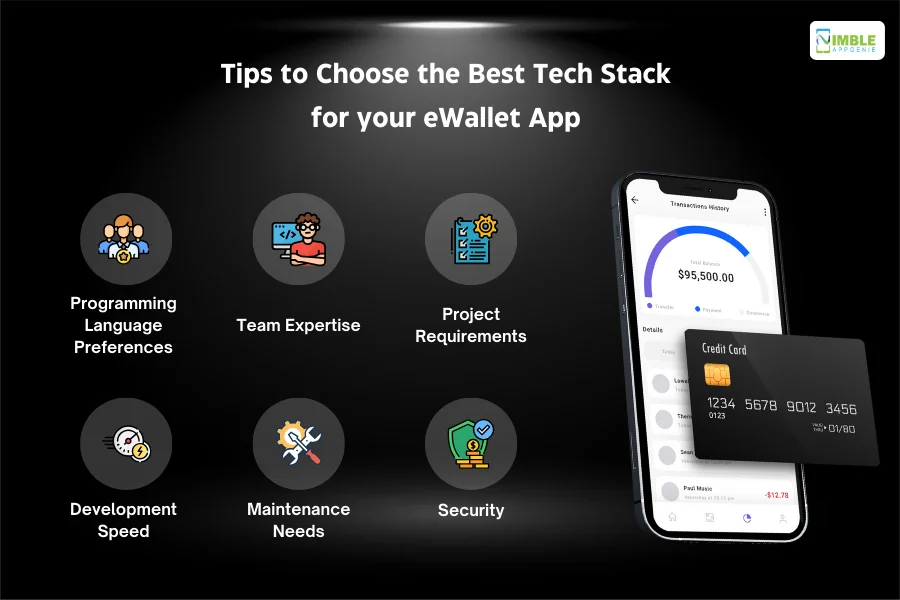
Well, we shall be looking at some considerations when choosing a tech stack.
1. Programming language preferences
If you are planning to hire mobile app developers or already have a team, it’s important to consider their programming expertise. More often than not, app developers have proficiency in a few languages.
In addition to this, different programming languages deliver varying performance and scalability. That’s why it is important to consider when choosing a tech stack.
2. Team expertise
When selecting or building a tech stack, always make sure to match it with your team’s expertise and what they have been using in their projects.
However, this doesn’t mean that you shouldn’t consider upskilling opportunities for the team.
3. Project requirements (scalability, performance, data model, features)
It goes without saying that every app development project is unique and comes with its own unique set of requirements.
This includes considering elements like scalability, app’s performance, feature set, and so on. Something that you should keep in mind is, the app’s requirements are always changing.
It is inevitable to, update the app. The tech stack you are moving forward with should be good enough to accommodate it.
4. Development speed
Some of the most common questions are:
“How Long Does It Take To Develop An App?”
The truth is that the time to develop an eWallet app highly depends on various factors, and tech stack is one of them.
While there are specific technologies that enable faster development (for instance, react native enables you to build Android apps and iOS apps with the same code), others require more development time.
5. Maintenance needs
Most app maintenance and support services are crucial to keep the eWallet app up and running.
Now, here’s how the eWallet app tech stack comes into play. While there are some technologies that are easier to maintain, on the other hand, there are some tech stacks that require a lot of work just to keep running.
This is one of the big factors to consider.
6. Security
When we talk about eWallet, security takes a place of uttermost importance.
Now, there are various ways to add another layer of security, including biometric authentication, dual-step verification, and so on.
But at the end of the app, to ensure complete eWallet app security, it’s important to choose the right tech stack for eWallet. This includes choosing technology that offers better security and compatibility for communication.
So, these are the considerations to keep in mind when you choose tech stack to use for ewallet app development.
Nimble AppGenie, A Vetted eWallet App Development Company Here To Help You
Confused about the eWallet app tech stack? You aren’t the only one. But we are here to save the day.
Nimble AppGenie, a market-leading eWallet app development company, has helped several clients choose the right tech stack for their eWallet app project and build an innovative app.
With over 700 projects under our name and recognition from top platforms like Clutch. co, TopDevelopers, GoodFirms, and DesignRush, we have what it takes to deliver the app you are looking for.
Contact us today; we will assign a team of app developers to you within 24 hours.
Conclusion
More and more companies are investing in eWallet apps as the market hit cross multi-billion dollar market. If you want to create an eWallet application that stands out from the rest and helps you win a competitive advantage, it’s important to choose the right tech stack. eWallet app tech stack can make your platform or break your platform. In this blog, we discussed all you need to know about the same.
FAQs
There isn’t one single most important factor, but rather a combination of considerations that should guide your decision. These include:
- Project requirements
- Team expertise
- Development speed
- Budget
- Security
Some commonly used tech stacks include:
- Frontend: React Native, Flutter, Xamarin
- Backend: Node.js + Express.js, Java + Spring Boot, Python + Django
- Database: MongoDB, PostgreSQL, MySQL
- Cloud: AWS, Azure, Google Cloud Platform
- Payment Gateways: Stripe, PayPal
- Financial APIs: Plaid, Finicity
While pre-set tech stacks can be a good starting point, a custom stack can be tailored to your specific needs and goals. This can lead to improved performance, security, and developer productivity.
Average cost to build eWallet ranges between, $25,000 and $100,000, it greatly depends on the complexity of your app, the tech stack, and development team’s location. A basic eWallet app could cost tens of thousands of dollars, while a more complex app with advanced features could cost hundreds of thousands or even millions.
- Nimble AppGenie blog
- eWallet Developer Forum
- Mobile App Development Tutorial

Udai Singh is a senior content writer with over 6 years of experience in creating content for FinTech, eWallet, EdTech, and App Development. He is an expert in simplifying complex concepts and creating engaging content that resonates with the audience.
Table of Contents













No Comments
Comments are closed.